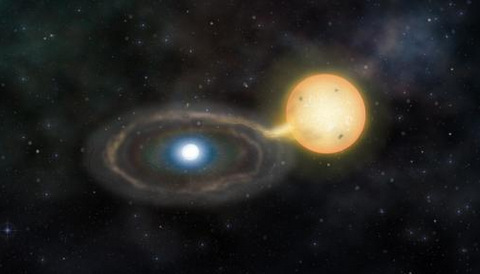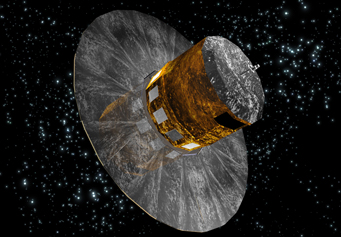Amateur and professional astronomers worked together to discover a rare eclipsing binary system — and a chance to study a supernova before it happens.

Marisa Grove / Institute of Astronomy
A collaboration of amateur and professional astronomers has uncovered a rare variety of eclipsing binaries. The European Space Agency’s Gaia satellite first imaged the eclipsing pair, named Gaia14aae, in August 2014. Researchers took notice of Gaia14aae when it suddenly flared five-fold within a single day.
The Gaia14aae system is composed of a white dwarf in a tight orbital embrace with a larger (by volume) companion. The tilt of orbit is along our line of sight, so observers on and near Earth — such as the Gaia mission in space — see an eclipse of the pair once every 50 minutes.
A worldwide pro-am collaboration carried out follow-up observations of Gaia14aae, cinching its nature as an eclipsing binary star. This effort included the Centre for Backyard Astrophysics (CBA), a group of amateurs who monitor cataclysmic variables using small telescopes in backyards around the world. CBA members kept eyes on the system after Gaia’s initial sighting of its outburst, as did a collaboration of 86 professionals based at facilities including the Catalina Real-time Transient Survey, PanSTARRS-1, and ASAS-SN based in Chile and Hawaii.
“Enrique de Miguel from CBA noticed that the system appeared to be eclipsing, based on a period of dips in the brightness of the system,” says Morgan Fraser (Cambridge Institute for Astronomy, UK). “From this, we realized that this could be quite an exciting system, and this led us to take further observations.”
This movie shows 30-second exposures from the Loiano Observatory over a span of 88 minutes (sped up by a factor of 250), revealing two eclipses of the Gaia14aae system.
Gaia14aae is located 730 light-years from Earth in the constellation Draco. The ‘Gaia14aae’ designation denotes the discovery year (2014) followed by the sequence, with ‘aaa’ being the first object of interest discovered in that particular year. Astronomers conducted spectroscopic analysis of the system using the William Herschel Telescope in the Canary Islands. They found that Gaia14aae is in fact a rare type of binary system that varies dramatically in brightness over short periods of time, known as an AM Canum Venaticorum (AM CVn) cataclysmic variable. This type is characterized by the absence of hydrogen and the abundance of helium in its spectrum.
Forty other such binary systems are known, but this one’s an eclipsing binary, each star passing in front of and blocking the light of its partner in turn. Eclipsing binaries are valuable because they reveal a key ingredient, the tilt of the system’s orbit — it has to be edge-on for the stars to eclipse each other. Knowing that one fact makes calculating other properties, like the mass of the two stars and the distance between them, easy.
A Supernova in the Making

ESA
The discovery is important to researchers studying Type 1a supernovae, the apocalyptic explosions of white dwarfs that eat too much and whose detonations shine with a characteristic brightness. These “standard candles” are crucial for measuring extragalactic distances and serve as a cornerstone for the discovery of the acceleration of the expansion of the universe due to dark energy.
Here, we’re seeing the anatomy of a probable Type 1a supernova in the making: a star 125 times the volume of our Sun locked in a death spiral with a white dwarf 100 times more massive than it. Researchers are unsure whether the two stars will collide in a dramatic supernova explosion, or if the white dwarf will devour its tenuous companion first.
The eclipsing nature of the system gives researchers the unprecedented opportunity to measure the physical parameters of a Type 1a supernova before it occurs. A galactic supernova courtesy of Gaia14aae would be easily visible from Earth, though such a spectacle is probably still thousands of years in the future.
“The eclipse means we can measure exactly the mass of both stars and their separation and work out their evolution,” says Heather Campbell (Cambridge Institute of Astronomy, UK). “The system could also be an important laboratory for studying ultra-bright supernova explosions, which are a vital tool for measuring the expansion of the universe.”
Fraser adds that the masses are essential to testing theory. “This means we can start to understand how systems like Gaia14aae come about — and what it would have looked like billions of years ago when it formed,” he adds.
More Discoveries to Come
And this could be the first of many exciting new discoveries. “This year, [the Gaia team has] been searching for new transients in a very manual way, but we are switching to doing things in a much more automated way,” says Campbell. “This means we will start finding lots more transients every day. Many of these will be supernova explosions, but it also opens up the potential for finding many more exciting objects.“
Launched in 2013, the Gaia observatory’s primary mission is astrometry, or the ultra-precise measurement of stars’ positions. As a spinoff, researchers expect Gaia to make serendipitous discoveries both near and far during its five-year mission, including new asteroids, comets, Kuiper Belt objects, variable stars, quasars, and much more. Gaia may spy transiting exoplanets as well.
The discovery of Gaia14aae is a great example of amateur and professional astronomers working together, and a sign of more exciting discoveries to come down the road.
Read the original paper of the discovery, "Total eclipse of the heart: the AM CVn Gaia14aae/ASSAN-14cn" in the Monthly Notices of the Royal Astronomical Society.
 4
4
Comments
Bernard-Venasse
September 5, 2015 at 10:12 am
Fascinating!
Where is this object located? Constellation Draco covers a large area of the sky!
Magnitudes would be useful too. Stating that the object was discovered and studied by pro-am astronomers only whets the apatite!
Bernie
You must be logged in to post a comment.
DSailing
September 6, 2015 at 8:59 am
I'm having trouble visualizing a white dwarf 150 times the size of the sun. Wouldn't the electrons be more tightly bound to atoms? If not then shouldn't Jupiter be 375 solar radii?
I'm guessing that the smaller mass is either not one of those Fermi things or more massive than its minimum mass.
You must be logged in to post a comment.
Marc Dubbeldam
September 8, 2015 at 10:48 am
The numbers quoted in the scientific paper are:
mass of the primary (white dwarf): 0.78 times the mass of the sun;
mass of the secondary: 0.015 times the mass of the sun;
orbital separation: 0.41 times the radius of the sun.
These are lower limits based on the assumption that the system's inclination is 90 degrees (i.e. perfectly edge-on); actual figures could be higher (with masses of 1.16 and 0.15 times the mass of the sun for an inclination of 80 degrees) but further observations are necessary to more accurately constrain the inclination.
Given that the total mass of the system is (likely) below the Chandrasekhar limit (of ~ 1.4 solar mass), how likely is it that the system will end its life as a Type 1a supernova?
You must be logged in to post a comment.
Peter Wilson
September 8, 2015 at 9:39 pm
Thanks for the clarification, Marc. I don't see any possibility of a Type 1a supernova.
Also, the companion is about 1/5th the diameter of the Sun, i.e. it's 1/125th the Sun's volume, not 125 times! White dwarfs, on the other hand, are about the size of Earth. I think the author was trying to make the point that the companion is only about 1/50th the mass of the white dwarf, but hundreds of times bigger.
You must be logged in to post a comment.
You must be logged in to post a comment.